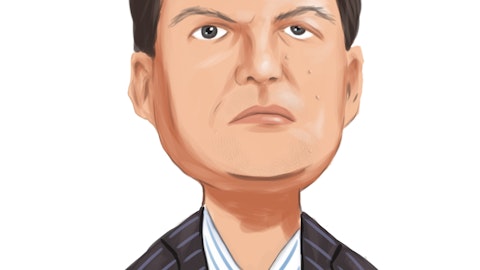Coherent, Inc. (NASDAQ:COHR) Q2 2024 Earnings Call Transcript February 6, 2024
Coherent, Inc. isn’t one of the 30 most popular stocks among hedge funds at the end of the third quarter (see the details here).
Operator: Good day, and thank you for standing by. Welcome to the Coherent Corp. Fiscal Year 2024 Second Quarter Earnings Conference. At this time, all participants are in a listen-only mode. After the speakers’ presentation, there will be a question-and-answer session. [Operator Instructions] Please be advised that today’s conference is being recorded. I would now like to hand the conference over to the Vice President of Investor Relations for Coherent Corp., Paul Silverstein.
Paul Silverstein: Thank you, Carmen, and good morning, everyone. Thank you for joining our second quarter fiscal 2024 earnings call. The call will be available for webcast replay on the Investor Relations section of our website. On the call, we have Coherent’s Chair and CEO, Dr. Chuck Mattera, and a number of Coherent senior leaders, who Chuck will introduce shortly. This morning, we will devote majority of our time to answer questions from analysts and the investment community. Yesterday, after market close, we issued a press release, posted a shareholder letter and updated investor presentation to the Investor Relations section of our website and first these documents in a Form 8-K. This morning, we filed our 10-Q. The shareholder letter contains the financial statements historically included in our earnings press releases and detailed information regarding our operating performance, key trends and outlook.
Before we begin, a short statement about forward-looking statements. We may make and/or refer to forward-looking statements, including statements about future performance and market outlook. Actual results may differ from those in the forward-looking statements. The shareholder letter and our SEC reports set forth risk factors that could cause actual results to differ materially. We assume no obligation to update forward-looking statements, which speak only as of their respective dates. During this call, we may discuss both GAAP and non-GAAP financial measures. If we do, a reconciliation of GAAP to non-GAAP measures is included in the shareholder letter. If we present historical non-GAAP financial measures, we will limit our discussion to those that are reconciled in the shareholder letter.
Before I turn the call over to Chuck for his opening remarks, please note that on March 26 at the Optical Fiber Conference, or OFC, in San Diego, we plan to host a meeting with the investment industry, which will be webcast, during which we will provide an update regarding our communications market. And in April of this year, we plan to host our third market overview webinar. It will be focused on our instrumentation market. The first two market webinars focused on our communications and industrial markets are available on the Investor Relations section of our website. With that, it is my pleasure to turn the call over to Coherent’s Chair and CEO, Dr. Chuck Mattera.
Chuck Mattera: Thank you, Paul. It’s a great day here in Silicon Valley, close to most of our largest customers. As I’ve said before, leadership development is among the CEO’s most important responsibilities. Given the shareholder letters extensive disclosures, I have asked the following senior leaders who participate in the Q&A fireside on today’s call: Rich Martucci, Interim Chief Financial Officer; Bob Bashaw, President; Dr. Giovanni Barbarossa, Chief Strategy Officer and President Materials segment; Sohail Khan, Executive Vice President Silicon Carbide LLC, our newly created subsidiary for our silicon carbide business; Dr. Chris Dorman, Executive Vice President, Lasers, who came to us through the Coherent acquisition; Magnus Bengtsson, Chief Commercial Officer who leads our global sales and service organization and who also came to us through the Coherent acquisition; Dr. Sanjai Parthasarathi, Chief Marketing Officer; and Dr. Julie Eng, Chief Technology Officer.
As being among the industry’s best, they will provide investors a rich source of information about the depth and breadth of our markets, technologies, operations and overall business. We emerged from the second quarter with greater confidence and excitement regarding a return to stronger growth and meaningfully enhanced profitability. For the quarter, we delivered solid sequential improvement in revenue and margins. The highlights of our second quarter include: healthy sequential increases in both gross and operating margin, ongoing AI driven strength in the datacom vertical of our communications market, signs of improving demand in all four verticals within our industrial market, and the telecom vertical of our communications market for the confirmation of the previously announced transactions with Mitsubishi Electric and DENSO Corporation, in which they invested in aggregate of $1 billion in our silicon carbide business and entered into long-term supply agreements supporting demand for silicon carbide substrates and epitaxial wafers; and five, an increase in our planned debt repayment in fiscal 2024, resulting from the Silicon Carbide LLC being able to fund its own operating and capital expenditures.

While we expect that the higher revenue and the mix in our forecast will contribute to a rebound in margin structure, we are not waiting for improved end market demand to carry us. We’ve already implemented actions across virtually all of our businesses in a drive for enhanced operating efficiency. These actions, along with rigorous cost and expense control across the company, helped drive our sequential improvement in gross and operating margin in the second quarter. We are on a roll, but we’re far from done. As we continue to transform the company to improve operating performance, we will optimize our production footprint and enhance operating resiliency while completing the integration of legacy Coherent. We also are exploring other strategic opportunities, not including material acquisitions to unlock shareholder value.
Now for some numbers. While the macroeconomic environment continues to present challenges, we are pleased with our operating results for the quarter. We posted revenue of $1.131 billion, which was above the midpoint of our guidance, and non-GAAP EPS of $0.36, which was above the high end of our guidance. Operating cash flow was $67 million. We invested $91 million in capital equipment and we retired $89 million of debt. In addition to continuing to invest in our core assets, we are taking substantive actions to ensure we improve our resiliency and operating performance, especially to drive improvement in our margin structure, including through global integration and transformation and the realization of our synergy plan from the legacy Coherent acquisition, as well as our previously announced restructuring and consolidation plan.
Our guidance for the third quarter of fiscal 2024 is as follows: revenue of approximately $1.12 billion to $1.20 billion, non-GAAP earnings per share of approximately $0.32 to $0.52. And our updated guidance for fiscal 2024 is revenue of $4.55 billion to $4.70 billion, which represents a $50 million increase at the low end of our previous guidance. Non-GAAP earnings per share of $1.30 to $1.70, which is up from $1 to $1.50 previously. Before we take your questions, I would like to say how appreciative and how proud I am of the senior leaders on this call and all of our other employees who started with dedication for setting the stage for what’s now, next and beyond. Coherent is well-positioned with differentiated technology, exceptional talent and high-quality efficient manufacturing platforms capable of delivering products to markets that are rapidly growing.
And I believe we are better positioned than others to take full advantage of our existing market positions and to penetrate deeper into these markets, largely because of the intimacy, trust and partnerships we have cultivated with market leaders and our increased scale, creating stability in our core business and creating a flywheel effect of other growth opportunities that many of our competitors simply don’t have. In the upcoming years, we have tremendous upside potential and platform cost optimization attributable to the ongoing legacy Coherent integration, special restructuring and transformation projects that we’ve announced. We expect success given our proven track record and have a strong plan and road map in place, which will allow us to capitalize on the recovery and growth in our markets and of the broader market opportunities.
We are endowed with a team of world-class technologists, industry pioneers and executives with a demonstrated capability for identifying and capitalizing on market mega trends. With that, I’ll turn it over to Paul. Paul?
Paul Silverstein: Thank you, Chuck. We will now open the call for analyst questions. Please limit yourself to one question. This call is scheduled for an hour. With that, Carmen?
See also 15 Best States for First-Time Homebuyers and 10 Best Australian Stocks To Buy.
Q&A Session
Follow Coherent Inc (NASDAQ:COHR)
Follow Coherent Inc (NASDAQ:COHR)
Operator: Thank you. One moment for our first question. [Operator Instructions] Our first question comes from Samik Chatterjee with JPMorgan. Please proceed.
Samik Chatterjee: Hi. Good morning, and thanks for taking my question. Congrats to the entire team there on the strong execution. Maybe just because it’s one question, if I keep to datacom. In the shareholder letter, you referred to a number of new significant AI related customers that you have engagements with. If you can give us a bit more insight about the nature of those customers, the magnitude potentially of those engagements can turn into if you were to win those awards relative to the existing orders that you have. And then just a quick clarification. You did have 100% sequential growth in datacom, 800 gig revenue on capacity ramp, is that roughly where we should expect sort of capacity to linearly expand from here on? Thank you.
Chuck Mattera: Yeah. Good morning, Samik. Thanks for your question. Sanjai?
Sanjai Parthasarathi: Sure. Thanks for your question, Samik. So with any large scale deployment of new technology, there are a few hyperscalers drive it, and now we are seeing that to extend more broadly. We’re also engaged with new MEMs as well as up and down the entire ecosystem. So we have a very broad group of customers that’s continuing to grow in terms of engagements. Did that answer your question?
Samik Chatterjee: Yeah. Anything on the capacity ramp, Sanjai?
Sanjai Parthasarathi: So in the capacity ramp, we did say in the shareholder letter that we grew 100%. That’s basically our 800G shipments, 100% quarter-over-quarter. In our ramp up plans, we hit the quarterly — we crossed the quarterly run rate of $100 million. And we also said that in fiscal ’24, Samik, that over 50% of our datacom transceiver revenues will be from AI related applications. So we are really excited with the ramp and the growth of the market.
Chuck Mattera: And I’m expecting the third quarter will be greater than the second quarter and the fourth greater than the third, Samik. If that gives you any indication.
Samik Chatterjee: Yeah. Sure. Thank you. Thanks for taking the question.
Chuck Mattera: Thank you.
Operator: Thank you. One moment for our next question, please. Comes from the line of Ruben Roy with Stifel. Please proceed.
Ruben Roy: Thanks very much and I’ll echo my congrats to the team. A follow-up for my one question on networking as well. Chuck, just trying to understand the commentary around the supply constraints. It sounds like they improved, lead times are shortening. Would you say your — the majority of the supply chain constraints are behind now and it’s a question of shipping to demand or are there still some components that are out there that are in short supply? Is that kind of a limiting factor to the rest of the year on your AI transceiver shipments?
Chuck Mattera: Okay. Thanks a lot, Ruben. Ruben, as you know, anytime you go through such a steep ramp, what’s lying in front of you with regard to constraints is what you’re trying to get out in front of. So if you look in the rearview mirror, the constraints have surely eased and moderated. But when you see the size of the ramp that we’re going up, we have to manage a number of constraints. The first constraint, then the second and third, we have to anticipate them. We have to get our agreements with suppliers in place. And we’re looking beyond FY ‘24. This is a super, super exciting and super-hot market. So we’re in the process of looking out well into FY ‘25 to be sure that our supply chain can keep up with us. I hope that answers your question, Ruben.
Ruben Roy: It does. Thank you for that detail chart.
Operator: Thank you. One moment for our next question, please. And it comes from the line of Meta Marshall with Morgan Stanley. Please proceed.
Meta Marshall: Great. Thanks. A couple of questions. Just one, just what are you seeing on inventory of under kind of this 800 gig or AI transceivers, just kind of when you expect some of the demand for that business to come back? And then just kind of on top of that, a couple of quarters ago, you had noted that you had a couple of hundred million of orders that if you ramp capacity, you expected to be able to fulfill during this fiscal year. Obviously, you guys are kind of ramping a little bit faster than expected just in terms of that kind of couple of hundred million that you outlined earlier in the year. Just how do you feel like you’re going to be able to meet or exceed kind of those excess demand?
Chuck Mattera: Thanks, Meta. Thanks for your interest. Sanjai?
Sanjai Parthasarathi: Yeah. Thanks for your question, Meta. So our — so we just said in our shareholder letter that we shipped over 100 million in 800G transceivers last quarter. It was much smaller the previous quarter, it grew almost 100% quarter-over-quarter. And then we also said, Meta, that in fiscal ’24, 50% of our datacom transceiver revenues will be from AI related applications. So we are projecting a very strong growth in our 800G shipments. We are on a ramp-up, as Chuck referred to earlier. Hopefully, that answered your question.
Meta Marshall: I guess — but just in terms of what are you seeing in terms of inventory clearing on the kind of sub-800 gig versus — I mean, I understand the 800-gig commentary, but what are we seeing just in terms of any other demand on the remainder of the business?
Sanjai Parthasarathi: Okay. So we haven’t factored in any huge rebound in the non-AI business in datacom. And that’s one of the — but most of the growth is in 800G. Pretty much all of the growth is in 800G. And that’s why we said over 50% of our fiscal ’24, our revenues will be from AI and related 800G products.
Meta Marshall: Great. Thank you.
Chuck Mattera: Thank you.
Sanjai Parthasarathi: Thank you.
Operator: Thank you. One moment for our next question, please. And it comes from the line of Simon Leopold with Raymond James. Please proceed.
Simon Leopold: Thanks for taking the question. I wanted to as well talk about what’s happening in 800-gig data center transceivers. And I’m looking for your thoughts on how you can compete in this market. And I’m struggling candidly because it seems like demand is great, which should be margin favorable, but some of your competitors probably are willing to take lower margins and so that might pressure profitability. Could you help us understand how you’re thinking about that? Thank you.
Chuck Mattera: Thanks, Simon. Giovanni, would you like to give….
Giovanni Barbarossa: Simon, good morning. Thanks for the question. Well, as a reminder, we are the most vertically integrated player in the space. So we heard, for example, people talking about shortage of pixels. Well, guess what, we have the largest bit supply in the world by far, so including obviously our competitors. So we have a very good kind of control of the supply line for the [indiscernible] components other than ICs. And we have our own manufacturing. We have pretty much the most complete offering in the space, both 100 and 200G as we announced in the past. So we think that will be very, very powerful, not only to remain competitive standpoint and a road map standpoint, which are very strategic to our hyperscale customers and the like, but also from a cost structure standpoint.



